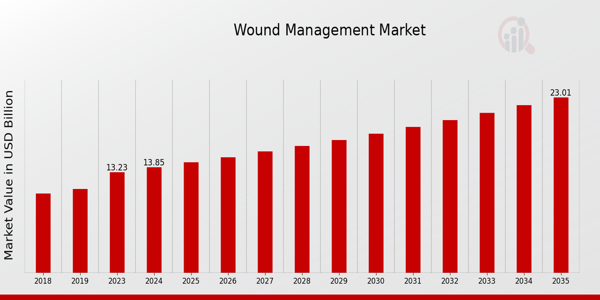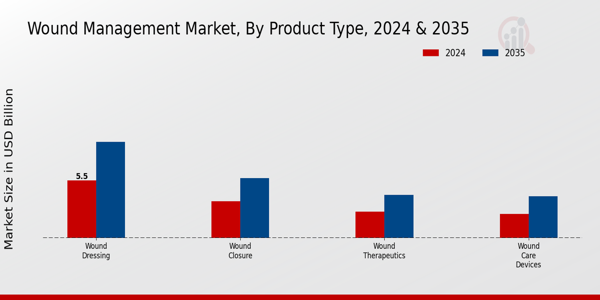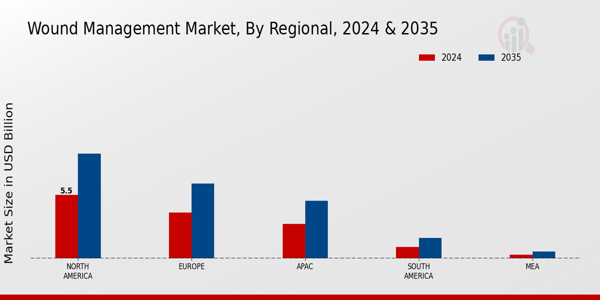Wound Management Market Overview
As per MRFR analysis, the Wound Management Market Size was estimated at 13.23 (USD Billion) in 2023. The Wound Management Market Industry is expected to grow from 13.85(USD Billion) in 2024 to 23.0 (USD Billion) by 2035. The Wound Management Market CAGR (growth rate) is expected to be around 4.72% during the forecast period (2025 - 2035).
Key Wound Management Market Trends Highlighted
The Global Wound Management Market is influenced by several key market drivers, including the rising incidence of chronic wounds, an aging population, and an increasing prevalence of diabetes and other health conditions that require effective wound care solutions. Advances in medical technology and a growing focus on patient-centered care are further propelling market growth. Healthcare providers are increasingly looking for innovative materials and methods to improve healing times and reduce complications, leading to an uptick in demand for specialized wound dressings and advanced therapies. There are numerous opportunities to be explored in this market, particularly in the development of biologic and regenerative wound therapies.The integration of technology, such as telemedicine and smart dressings, provides a chance for companies to enhance their product offerings and improve patient outcomes. Additionally, emerging markets present a significant opportunity for growth, as rising healthcare expenditures and increased awareness about wound care create a broader customer base. Companies that focus on forming strategic partnerships and collaborations with healthcare professionals can also capture a larger share of this evolving market. Recent trends include a shift towards more advanced wound care products, such as antimicrobial dressings and negative pressure wound therapy systems.The adoption of telemedicine for wound management has also gained traction, allowing for remote monitoring and consultations that enhance patient care. There is a growing recognition of personalized treatment plans, where therapies are tailored to individual patient needs, improving healing rates. Sustainability in wound care product manufacturing is becoming a focal point as consumers demand eco-friendly solutions. Overall, the Global Wound Management Market is poised for steady growth as it continues to adapt to changing healthcare needs and technological advancements.

Source: Primary Research, Secondary Research, MRFR Database and Analyst Review
Wound Management Market Drivers
Growing Incidence of Chronic Wounds
The increasing prevalence of chronic wounds, such as diabetic ulcers and pressure sores, significantly drives the Global Wound Management Market Industry. The rising incidence of lifestyle-related diseases, including diabetes, obesity, and vascular diseases, has resulted in a surge in the need for effective wound management solutions. As the global population ages, the number of individuals suffering from these chronic conditions is expected to rise, thereby increasing the demand for advanced wound care products and services.Moreover, chronic wounds are often complicated by comorbidities and require specialized treatment to promote healing. This trend prompts healthcare providers to invest in innovative wound management technologies and practices. Furthermore, advancements in wound care products, including active dressings and biologics, contribute to improved healing rates and better patient outcomes. The shift towards home healthcare settings also requires effective wound management solutions, as patients are increasingly being treated for chronic wounds outside of traditional clinical environments.
Technological Advancements in Wound Care
Technological innovations play a critical role in propelling the Global Wound Management Market Industry forward. The advent of advanced wound care products, such as hydrocolloid dressings, foam dressings, and negative pressure wound therapy, has revolutionized the way wounds are treated. These products not only enhance healing but also improve patient comfort. Additionally, the integration of cutting-edge technologies, such as bioengineered skin substitutes and smart dressings capable of monitoring wound conditions, allows for more tailored treatment approaches.Hospitals and clinics increasingly adopt these technologies to improve clinical outcomes and patient satisfaction.
Increase in Healthcare Expenditure
The rise in healthcare expenditure across the globe is substantially driving the growth of the Global Wound Management Market Industry. Governments and private sectors are increasingly allocating funds to improve healthcare infrastructure and services. With higher budgets, healthcare facilities are more capable of investing in advanced wound management products, leading to better patient outcomes and reduced complications. Furthermore, the focus on value-based care incentivizes healthcare providers to adopt effective wound care solutions that minimize complications and hospital readmissions, ultimately leading to better resource utilization and cost efficiency.
Wound Management Market Segment Insights
Wound Management Market Product Type Insights
The Global Wound Management Market revenue showcases a diverse classification by Product Type, comprising Wound Dressing, Wound Closure, Wound Therapeutics, and Wound Care Devices, with each segment contributing significantly to the overall market dynamics. In 2024, Wound Dressing accounted for a valuation of 5.5 USD Billion, establishing itself as a dominant player that addresses the need for effective and efficient wound care solutions. By 2035, this particular segment is projected to grow to 9.2 USD Billion, highlighting its substantial hold within the market, attributed to the rising incidences of chronic wounds and the increasing demand for advanced wound care products. Following is Wound Closure, valued at 3.5 USD Billion in 2024 and forecasted to reach 5.7 USD Billion by 2035, indicating its significant role in surgical and traumatic wound closure procedures. This segment's growth is driven by the ongoing advancements in materials and techniques used in sutures and adhesives, leading to better patient outcomes.
Wound Therapeutics, encompassing innovative treatment options, represented a market value of 2.5 USD Billion in 2024 and is expected to reach 4.1 USD Billion by 2035. This segment plays an essential role in the overall Wound Management Market industry as it addresses complications associated with various wound management practices, thus contributing to improved healing processes. Finally, Wound Care Devices, with a valuation of 2.3 USD Billion in 2024 and an estimated 4.0 USD Billion by 2035, essential for facilitating wound assessment and management.
The increasing prevalence of diabetic ulcers and pressure sores significantly highlights this segment's importance, as the device innovations aim to enhance patient safety and comfort. Overall, the Global Wound Management Market data reflects a balanced yet evolving landscape where Wound Dressing and Wound Closure take a majority holding, while Wound Therapeutics and Wound Care Devices also thrive due to the growing trend towards personalized and efficient wound management solutions that cater to diverse patient needs and conditions.

Source: Primary Research, Secondary Research, MRFR Database and Analyst Review
Wound Management Market Wound Type Insights
The market segmentation includes acute wounds, chronic wounds, surgical wounds, and burns, each representing unique needs and treatment approaches. Acute wounds, often resulting from injuries or accidents, require rapid intervention to promote healing and prevent complications. Chronic wounds, such as diabetic ulcers and venous leg ulcers, represent a significant challenge in geriatric care, demanding ongoing management and specialized products.Surgical wounds are pivotal due to the rising number of surgical procedures worldwide, emphasizing the need for products that enhance recovery and minimize infection risks. Burns also hold significant importance, with increasing cases due to accidents and industrial exposure, calling for advanced dressing and wound care technologies. Collectively, these categories contribute to the diverse landscape of the Global Wound Management Market, supported by trends in healthcare advancements and an aging population, enhancing the overall market growth driven by innovative treatment solutions.
Wound Management Market End User Insights
The Global Wound Management Market revenue is influenced significantly by the End User segment, which encompasses various categories including Hospitals, Home Healthcare, Clinics and Long-term Care Facilities. Hospitals represent a crucial aspect of this segment, as they handle a wide range of complex wounds requiring advanced care and management. Home Healthcare is becoming increasingly relevant, providing patients with care in the comfort of their homes, thereby addressing both convenience and cost-effectiveness.Clinics serve as essential points for outpatient treatment, catering to various injuries and chronic wounds, while Long-term Care Facilities play a vital role in managing wounds for patients with prolonged health challenges. The significant utilization of wound care products in these settings is driven by an increasing aging population and a rising prevalence of chronic diseases. Additionally, the market growth is supported by advancements in wound care technologies and an increased awareness of infection control, contributing to the overall expansion of the Global Wound Management Market industry.The varied Global Wound Management Market statistics paint a picture of a diverse, evolving market landscape where each End User's unique needs contribute to the trends and growth opportunities available.
Wound Management Market Distribution Channel Insights
The Global Wound Management Market is poised for significant growth through various distribution channelsAmong these channels, Direct Sales plays a crucial role, allowing manufacturers to engage directly with healthcare providers and consumers. Online Sales have gained traction, offering convenience and wider access to wound care products, especially post-pandemic. Retail Pharmacies remain a vital component of distribution, providing immediate availability of wound management supplies to a diverse customer base.Health Care Distributors facilitate the extensive reach of products to hospitals and clinics, fostering efficiency in supply chains. Collectively, these distribution channels contribute to the overall dynamics of the Global Wound Management Market, addressing the evolving needs of patients and healthcare systems. With market trends leaning towards digitalization and consumer preference for accessible care solutions, the demand across these channels is anticipated to expand significantly, balancing the need for both immediate product availability and advanced logistical support.Thus, understanding the Global Wound Management Market segmentation is essential in comprehending the factors driving growth and the strategic opportunities that lie ahead.
Wound Management Market Regional Insights
The Global Wound Management Market is projected to witness significant growth across its regional landscape, with North America leading the market holding a prominent valuation of 5.5 USD Billion in 2024, expected to rise to 9.1 USD Billion by 2035. This region's dominance is attributed to advanced healthcare infrastructure and rising cases of chronic wounds. Europe follows with a substantial market value of 4.0 USD Billion in 2024, increasing to 6.5 USD Billion in 2035, driven by an aging population and heightened awareness regarding wound care.The APAC region, valued at 3.0 USD Billion in 2024 and expected to grow to 5.0 USD Billion by 2035, demonstrates significant potential due to increasing healthcare investments and rising diabetes prevalence. South America is projected at 1.0 USD Billion in 2024, growing to 1.8 USD Billion by 2035, showing gradual market growth attributed to improvements in healthcare access. Finally, the MEA region currently holds a value of 0.35 USD Billion in 2024, forecasted to grow to 0.6 USD Billion in 2035, benefiting from rising healthcare initiatives and increasing demand for advanced wound management products.The variance in market size across these regions highlights varying levels of healthcare development, resulting in significant opportunities for growth within the Global Wound Management Market.

Source: Primary Research, Secondary Research, MRFR Database and Analyst Review
Wound Management Market Key Players and Competitive Insights
The Global Wound Management Market is characterized by its dynamic and evolving landscape driven by technological advancements, increasing prevalence of chronic wounds, and rising awareness regarding wound care management. As the market continues to expand, key players are focusing on innovation in product development, enhancing therapeutic options for both acute and chronic wounds. Competitive strategies are heavily influenced by the need for effective wound care solutions that reduce healing time while minimizing complications. Additionally, the integration of advanced technologies such as biomaterials and bioengineered products into wound management solutions is creating competitive advantages among various market participants. As a result, understanding the competitive landscape becomes essential in identifying potential growth opportunities within this vital healthcare segment.Acelity has established a formidable presence in the Global Wound Management Market through its comprehensive portfolio of advanced wound care solutions.
The company's strengths lie in its innovative product offerings, which include a range of advanced dressings and therapies designed to promote healing while reducing the risk of infection. Acelity's strong emphasis on research and development enables it to stay ahead of the curve by introducing cutting-edge solutions that meet the evolving needs of healthcare providers and patients alike. The company's commitment to enhancing the quality of care through effective wound management practices has positioned it favorably in the market. Additionally, Acelity’s strong distribution network and strategic partnerships further enhance its market reach, allowing it to serve a diverse range of healthcare settings effectively.Integra LifeSciences has made significant strides within the Global Wound Management Market, driven by its focus on providing innovative solutions that address various wound care challenges.
The company specializes in regenerative technologies and advanced wound care products, catering to a wide audience that includes hospitals, clinics and outpatient facilities. Integra LifeSciences' strengths lie in its extensive research capabilities, enabling the development of unique products that leverage biological and synthetic materials for optimal healing outcomes. Its commitment to providing educational resources and training for healthcare professionals ensures optimal utilization of its products, reinforcing its reputation as a trusted partner in wound management. Through strategic acquisitions and collaborations, Integra LifeSciences continues to enhance its product offerings and expand its market presence, positioning itself as a key player in the wound management sector.
Key Companies in the Wound Management Market Include
- Acelity
- Integra LifeSciences
- Hollister
- Advanced Medical Solutions
- 3M
- ConvaTec Group
- Braun Melsungen AG
- Smith and Nephew
- Coloplast
- Derma Sciences
- Cardinal Health
- B. Braun Melsungen
- Medtronic
- Johnson and Johnson
Wound Management Market Industry Developments
Recent developments in the Global Wound Management Market have showcased significant advancements and strategic movements among key players. Acelity and ConvaTec Group continue to innovate with advanced dressings and negative pressure wound therapy solutions, responding to heightened demand for effective wound care. Similarly, 3M and Smith & Nephew have launched new antimicrobial dressings and technologies aimed at promoting faster healing. The market is experiencing substantial growth, driven by an increasing prevalence of chronic wounds and better healthcare infrastructural investments.Additionally, notable mergers and acquisitions have been shaping the competitive landscape. B. Braun Melsungen AG's acquisition of a niche player has strengthened its portfolio in the advanced wound care segments, while Medtronic continues to expand its offerings through strategic partnerships. The strong financial performance of companies like Hollister and Derma Sciences is further bolstering investor interest, attributing to the positive trajectory of wound management products in both market value and innovation. This ongoing dynamic within the market reflects a collective focus on enhancing patient outcomes through technological advancements and expansive product lines.
Wound Management Market Segmentation Insights
-
Wound Management Market Product Type Outlook
- Wound Dressing
- Wound Closure
- Wound Therapeutics
- Wound Care Devices
-
Wound Management Market Wound Type Outlook
- Acute Wounds
- Chronic Wounds
- Surgical Wounds
- Burns
-
Wound Management Market End User Outlook
- Hospitals
- Home Healthcare
- Clinics
- Long-term Care Facilities
-
Wound Management Market Distribution Channel Outlook
- Direct Sales
- Online Sales
- Retail Pharmacies
- Health Care Distributors
-
Wound Management Market Regional Outlook
- North America
- Europe
- South America
- Asia Pacific
- Middle East and Africa
|
Report Attribute/Metric
|
Details
|
|
Market Size 2023
|
13.23(USD Billion)
|
|
Market Size 2024
|
13.85(USD Billion)
|
|
Market Size 2035
|
23.0(USD Billion)
|
|
Compound Annual Growth Rate (CAGR)
|
4.72% (2025 - 2035)
|
|
Report Coverage
|
Revenue Forecast, Competitive Landscape, Growth Factors, and Trends
|
|
Base Year
|
2024
|
|
Market Forecast Period
|
2025 - 2035
|
|
Historical Data
|
2019 - 2024
|
|
Market Forecast Units
|
USD Billion
|
|
Key Companies Profiled
|
Acelity, Integra LifeSciences, Hollister, Advanced Medical Solutions, 3M, ConvaTec Group, Braun Melsungen AG, Smith and Nephew, Coloplast, Derma Sciences, Cardinal Health, B. Braun Melsungen, Medtronic, Johnson and Johnson
|
|
Segments Covered
|
Product Type, Wound Type, End User, Distribution Channel, Regional
|
|
Key Market Opportunities
|
1. Growing incidence of chronic wounds,
2. Rising demand for advanced wound care,
3. Increasing adoption of telemedicine,
4. Expansion of home healthcare services,
5. Technological advancements in wound treatment
|
|
Key Market Dynamics
|
1. Aging population,
2. Chronic disease prevalence,
3. Advanced wound care products,
4. Rising healthcare expenditure,
5. Increasing surgical procedures
|
|
Countries Covered
|
North America, Europe, APAC, South America, MEA
|
Frequently Asked Questions (FAQ) :
The Global Wound Management Market is expected to be valued at 13.85 USD Billion in 2024.
The Global Wound Management Market is expected to grow at a CAGR of 4.72% from 2025 to 2035.
The Wound Dressing segment is projected to reach 9.2 USD Billion by 2035.
North America is expected to dominate the market with a value of 5.5 USD Billion in 2024.
The Wound Closure segment is valued at approximately 3.5 USD Billion in 2024.
Major players in the market include Acelity, Integra LifeSciences, 3M, and Smith and Nephew.
The APAC region is expected to contribute around 5.0 USD Billion to the market by 2035.
The market value for Wound Care Devices is projected to be 4.0 USD Billion by 2035.
The Wound Therapeutics segment is expected to be valued at 2.5 USD Billion in 2024.
The MEA region is estimated to be valued at 0.35 USD Billion in 2024.

















